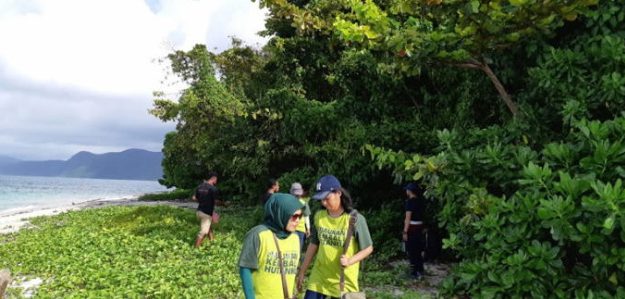KATANG-KATANG (BAYHOPS), A NEW THREAT FOR LEATHERBACK SEA TURTLE

-
Date:
30 Apr 2020 -
Author:
KEHATI
Katang-katang (Ipomoea pes-caprae), also known as bayhops that generally found in the beaches are actually a new threat for sea turtle reproduction. It was told by Fitri Pakiding, the turtle researcher from Universitas Negeri Papua, Monday (1/4/2019), in Manokwari, West Papua.
The Whitley Fund for Nature 2014 awardee told his observation on the plan relation with sea turtle eggs in Jeen Womom Beach, Tambrau north coastal, West Papua. On the Leatherback sea turtle nursing coast, the biggest sea turtle in the world, bayhops roots penetrate through the sand for the sea turtle places it eggs. Therefore, the bayhops roots take the nutrition from the egg until it dries.
It adds up the threats for the Leatherback Sea Turtle that is already endangered according to IUCN-redlist. In Indonesia, Leatherback Sea Turtle lays its eggs in the Jeen Womom Coastal Park, including the Jamursba Medi and Warmon beaches. This location is the only beach that routinely visited by the turtles to put its eggs. Bayhops is a common species that can easily found in a tropical beach, including Indonesia. In Tambrau, bayhops is called sweet potato, because of their similar looks.
The bayhops threat detected by the end of 2016 when the research institution from Universitas Negeri Papua held a turtle survey in Jeen Womom beach. According to Fitri, the bayhops threats came from the roots. “The roots suck up the nutrition from the inside of the egg until it dries out,” she said. She said that on the Bird’s Head Seascape (BHS) annual meeting in Manokwari, West Papua. The meeting was participated by some environmental NGOs such as CI Indonesia, WWF Indonesia, The Nature Conservancy (TNC), Rare, Starling Foundation, and Yayasan KEHATI.
Desy Lontoh, a researcher from Universitas Negeri Papua, routinely collects and analyzes the leatherback sea turtles data in Tambrauw said that bayhops is a serious threat for the turtles because it can make a failure of turtles nests from 1 period. “There was only 1% of nests that success to hatch,” she said.
Her research, in one survey she counted 500 turtle’s nests, but almost all of them are failed to hatch because it was covered with bayhops. The last survey from 2018 collected 350 turtle’s nests, but only 200 succeed because they translocate the nests. One of the reasons for the bayhops expansion is the big wave’s season, so most of the coastal areas are on the water. Therefore, the turtle tried to find further places for its nest that also a natural habitat for bayhops. The temporary solutions are to protect the nests with a barrier from the coconut stem, clean the beach from the bayhops, and relocate the nests. The latter solution is the most effective way to do it. CI Indonesia West Papua Program Manager, Yance de Fretes said that it is a natural phenomenon that there is a habitat competition between species because of the environment changes. He also said that further researches are needed to make sure the cause and long term solutions.
